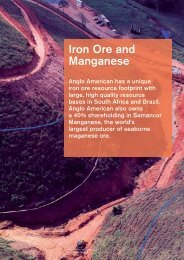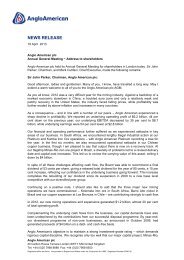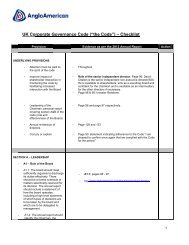pdf [ 4.9MB ] - Anglo American
pdf [ 4.9MB ] - Anglo American
pdf [ 4.9MB ] - Anglo American
Create successful ePaper yourself
Turn your PDF publications into a flip-book with our unique Google optimized e-Paper software.
38 Operating and financial review<br />
BUSINESS UNIT OVERVIEW CONTINUED<br />
De Beers production*<br />
Carats recovered (million)<br />
60<br />
50<br />
40<br />
30<br />
20<br />
10<br />
0<br />
03 04 05 06 07 08<br />
*DBCM, Debswana, Namdeb, Williamson<br />
and Canada<br />
Sorting rough diamonds at<br />
The Diamond Trading Company<br />
in London. In 2008, the De Beers<br />
group produced 48.1 million<br />
carats of diamonds<br />
Industry overview<br />
Up to two-thirds of the world’s diamonds by<br />
value originate from southern and central<br />
Africa, while significant sources have been<br />
discovered in Russia, Australia and Canada.<br />
Most diamonds come from the mining of<br />
kimberlite deposits. Another important source<br />
of gem diamonds, however, has been<br />
secondary alluvial deposits formed by the<br />
weathering of primary kimberlites and the<br />
subsequent deposition of released diamonds<br />
in rivers and beach gravels.<br />
Rough or uncut diamonds are broadly<br />
classified either as gem diamonds or industrial<br />
quality diamonds, with gem representing by<br />
far the larger of the two markets by value.<br />
The primary world market for gem diamonds is<br />
in retail jewellery where aspects such as size,<br />
colour, shape and clarity have a large impact<br />
on valuation. De Beers, through the DTC, and<br />
its partners in Botswana, South Africa and<br />
Namibia, supplies its clients – known as<br />
‘Sightholders’ – with parcels of rough diamonds<br />
that are specifically aligned to their respective<br />
cutting and polishing needs.<br />
Strategy and growth<br />
During 2008, De Beers continued to focus both<br />
investment and divestment activity to position<br />
the company for future growth. The strategy<br />
centres on exploration in central and southern<br />
Africa; driving profitable production growth<br />
across operations and seeking enhanced levels<br />
of organisational effectiveness. De Beers has<br />
been divesting from those mines that, under<br />
the company’s current cost structures, are<br />
deemed marginal or loss making. In 2008,<br />
De Beers completed the sale of the Kimberley<br />
underground mines and Cullinan Diamond Mine<br />
to Petra Diamonds Limited and the disposal of<br />
Williamson Diamond Mine in Tanzania.<br />
During the reporting period, De Beers<br />
officially opened its first mines in Canada at<br />
Victor mine in northern Ontario and Snap Lake<br />
mine in the Northwest Territories. Victor was<br />
completed and commissioned eight months<br />
ahead of schedule and Snap Lake commenced<br />
commercial production in early 2008 with<br />
both mines reaching full production in the<br />
second half of the year. In South Africa, the<br />
long-dormant Voorspoed mine was officially<br />
re-opened with its first diamonds being<br />
recovered in June. As a result of the coming<br />
on stream of these projects during the year,<br />
De Beers’ capital expenditure has declined<br />
significantly.<br />
In April, De Beers commissioned a new<br />
$83 million diamond facility in Gaborone,<br />
the largest and most sophisticated of its<br />
kind in the world, which is now home to the<br />
DTCB. This boost to beneficiation – adding<br />
downstream value to mining operations – in the<br />
producer country includes the process of sorting<br />
and valuing rough diamonds, their subsequent<br />
cutting and polishing, and the manufacture of<br />
diamond jewellery. The focus on beneficiation<br />
extends to Namibia through the NDTC, to<br />
South Africa through the State Diamond Trader<br />
and to Canada through local supply agreements<br />
reached with the governments of Ontario and<br />
the Northwest Territories respectively. All these<br />
initiatives seek to create an enabling<br />
environment through which each country’s<br />
valuable diamond resources can be further<br />
transformed into a source of national wealth,<br />
pride and development.<br />
In May, Judge Chesler entered an order in<br />
the US Federal District Court in New Jersey<br />
approving in all respects the Settlement in<br />
the Diamond Class Actions, which addressed<br />
De Beers’ outstanding historical civil legal issues<br />
in the US. Certain appeals have been noted<br />
against the order, which will be addressed in<br />
accordance with ordinary legal processes.<br />
The DTC completed its Sightholder selection<br />
process in 2008, appointing 78 clients for the<br />
new three-year contract period. Clients will be<br />
receiving ‘Sights’ through wholly owned and<br />
joint venture DTC operations around the world,<br />
with many of the Sightholders receiving Sights<br />
in several different countries. The selection<br />
criteria for Sightholders were designed to<br />
identify those applicants that demonstrated<br />
excellence in their technical ability, their<br />
distribution and marketing effectiveness<br />
and the core strengths of their diamond<br />
business. Financial transparency and ethical<br />
accountability were mandatory.<br />
DBDJ continued to expand its global<br />
network of operations in 2008.<br />
<strong>Anglo</strong> <strong>American</strong> plc Annual Report 2008


![pdf [ 4.9MB ] - Anglo American](https://img.yumpu.com/33613742/40/500x640/pdf-49mb-anglo-american.jpg)






![English PDF [ 189KB ] - Anglo American](https://img.yumpu.com/50470814/1/184x260/english-pdf-189kb-anglo-american.jpg?quality=85)




![pdf [ 595KB ] - Anglo American](https://img.yumpu.com/49420483/1/184x260/pdf-595kb-anglo-american.jpg?quality=85)
![pdf [ 1.1MB ] - Anglo American](https://img.yumpu.com/49057963/1/190x240/pdf-11mb-anglo-american.jpg?quality=85)

